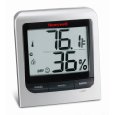Humidity is measured with a device called a hygrometer, which can be purchased at most of the home centers or HVAC supply houses. Today's hygrometers are mostly electronic (Figure 1) and are relatively inexpensive. Once you have determined the humidity level you can attempt to control it.

Figure 1 - Electronic hygrometer & thermometer
- If you operate room or central forced air humidifiers it is important to check and clean them regularly. One of the common causes of over humidification in homes are poorly maintained humidifiers.
- Electric or gas clothes dryers must be vented to the outside.
- Install and use exhaust fans when cooking and bathing
- Attic and crawl spaces need to be vented to the outside.
- Bare earth in crawl spaces should be covered with a vapor barrier.
- The room or area housing a forced air furnace should have a fresh air intake installed.
- Firewood should not be stored indoors.
Opening a window a couple of times a day, 1/4 to 1/2 inch will help to balance the dry outdoor air with the moist indoor air.
Install new windows that have a thermal barrier within the frame. A thermal barrier is created by having the inside frame of the window isolated from the outside frame and in doing so the inside frame stays at the same temperature as the room. The new window must be thermo-pane that is 2 independent pieces of glass separated with air. The air acts as a thermal barrier to outside cold.
It is almost impossible to get rid of all condensation. On very cold days or when you have placed a lot of moisture in the air, no matter what other precautions you have taken condensation may form. If you are monitoring your humidity levels and have taken all the other precautions any condensation problem should be very temporary.
Condensation can be a problem in both winter and summer.
Three conditions in the home increase the chances that condensation will occur.
The first of these is a relatively recent phenomenon. Many homeowners have added insulation to cut heat loss and heat gain, while others have caulked and applied weather-stripping around windows and doors to reduce the infiltration of cold air into their homes. The same practices that trap heat in the home also trap high levels of moisture.
A second common condition contributing to moisture problems in (northern) homes is the existence of cool surfaces with which interior moisture vapor naturally comes in contact. In less energy-efficient homes, certain locations are prime candidates for condensation problems because they commonly have cool surfaces. These include poorly weatherized and insulated windows (in winter), poorly insulated exterior walls and ceilings (winter), masonry or concrete surfaces (summer), toilet tanks (summer) and cold water pipes (summer).
A third condition contributing to household condensation problems is excessively high humidity levels in the air within the home. The normal indoor humidity range in winter is 15 to 50 percent. In the summer, the humidity range may be higher because of the higher outdoor humidity levels we sometimes experience then.
In order to reduce condensation you must reduce the humidity in your home.
